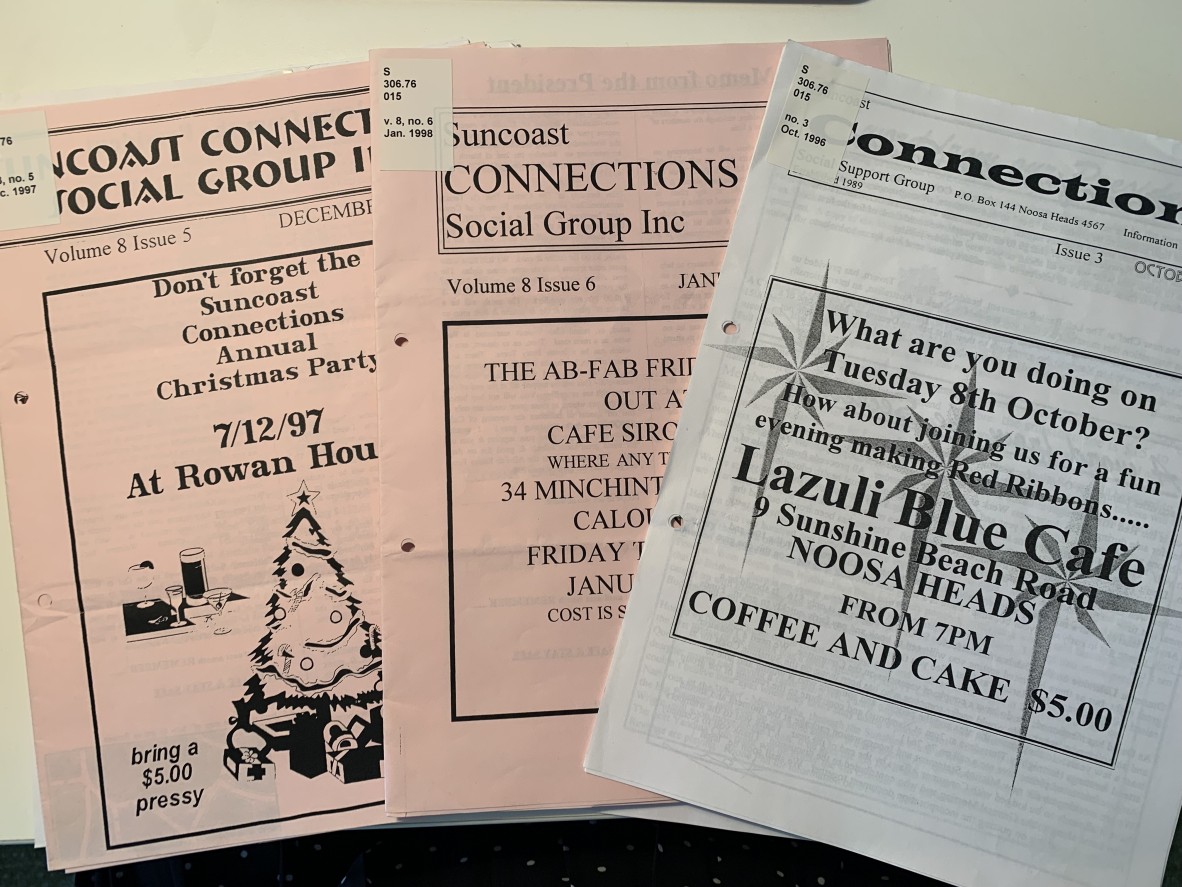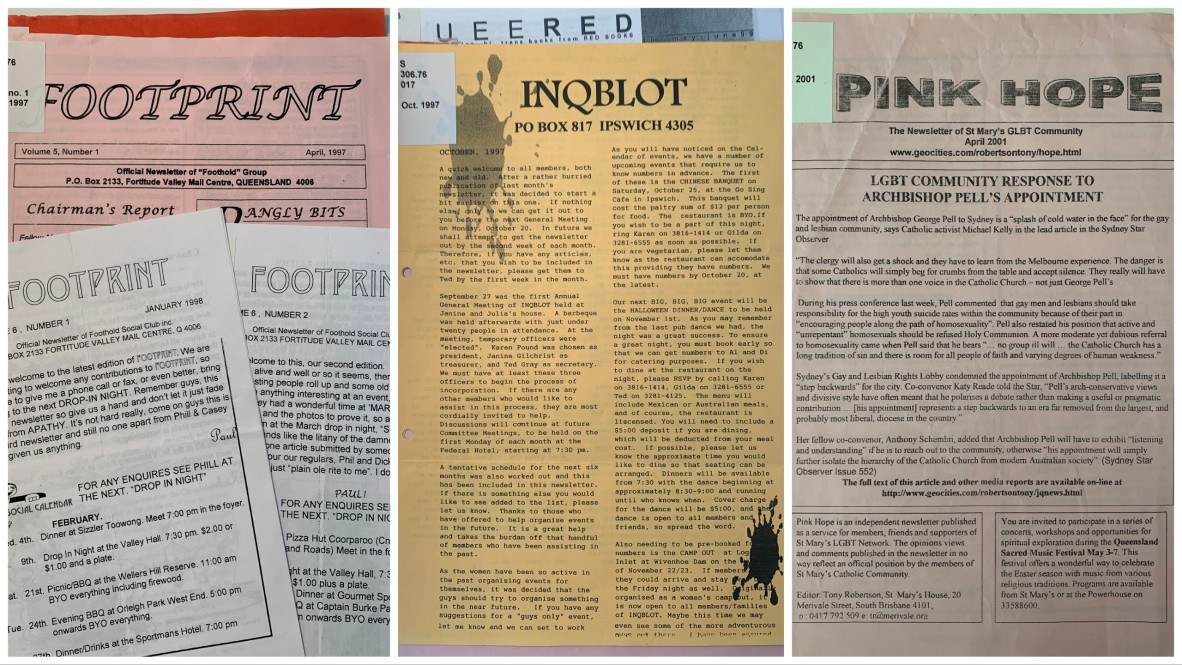Self-Publishing in Queensland’s Queer Communities
By Bianca Martin, 2022 Rainbow Research Fellow | 28 November 2023
In my attempt to piece together a contemporary history of queer zines in Queensland I have also found it incredibly useful to look further into the past to provide additional context to my research. The definition of a zine itself is inherently slippery and I believe there’s a lot of value in expanding this term more broadly to include other types of self-published materials such as newsletters and pamphlets. The intent of production remains the same, regardless of the output. Marginalised and under-represented communities self-publish for a variety of reasons, including personal expression and creativity, as a networking tool to connect with others and build community, or as a form of cultural resistance or political critique (Zobl 2009, p. 5). Ultimately self-publishing can be a means of challenging misrepresentation and taking the tools of cultural production into their own hands by sharing narratives that resist stereotyping.
Historically, independently published materials have been used within queer communities as a safe space to discuss things relevant to the community, to interrogate topics not covered in mainstream media, and to circulate knowledge and share resources (Lang 2014). These objects are not intended to act as historical documents designed to stand the test of time – much like zines, they are ephemeral and instead provide value in that moment of distribution. These self-published materials are designed to be circulated within their own community for a readership of like-minded people. However these materials have since proven to be useful as historical documents, helping research piece together histories of under-represented communities that haven’t otherwise been documented. These self-published materials capture reactions and responses to key historical moments outside of mainstream publishing and provide insight into what the ways communities reacted to or responded to certain events or moments in time.
From within the John Oxley Library collection there are a variety of queer self-published documents, ranging from social group newsletters and booklets, independently made magazines, informational pamphlets distributed by community organisations, and publications supported by university groups and student guilds. Sometimes these publications self-identify as zines while other times use newsletter and magazine interchangeably. I consider them all useful in the greater scope of my research as it provides further insight into how queer communities utilised self-publishing as a means of connection and community building.
Newsletters
In the mid-to-late 1990s paper newsletters proved to be a popular means of communication for social groups, networks, clubs, and collectives. It was not only a way to keep members updated on relevant events and meet-ups but also as a means of sharing information about and promoting safe queer-friendly spaces such as hairdressers, clothing stores, and restaurants. Newsletters tend to be location specific and timely as they are released on a more frequent basis.

Front covers of Suncoast connections zine. State Library of Queensland collection

Front covers of three zines - Footprints, Inqblot and Pink Hope
Newsletters such as these were utilised to promote and review in-person social events and meet-ups. They may contain notes from meetings, proposed gatherings related to holidays, and a calendar of upcoming events.
Self-Published Magazines
Likewise some collectives and community groups created their own self-published magazines. These would feature interviews with local queer owned businesses, opinion pieces on relevant issues, and advertisements and directories for known safe venues and events.

Front covers of three zines - In Step, Brisbane Scene and Seahorse News
Seahorse News for example was a bi-monthly magazine from The Seahorse Society of Queensland, “a social and support group for cross-dressers and their partners”. It featured opinion pieces on cross-dressing representation in the media, memoir and personal narratives for coming out stories, as well photos of community members at social occasions. This self-published magazine provided vital information within the cross-dressing community about safe spaces to try on and buy clothing, where to access health and beauty services, and venues other members of the community enjoy visiting.
University Publications
The social groups, clubs, and student guilds at universities have also taken on self-publishing. These booklets circulated around campuses to promote meet-ups and events, but to also provide students with information about advocacy and their rights. It was common for publications such as these to break down information about Centrelink and Austudy into plain and easy to understand language. They would provide information about safe sex practices and listed health services available to students on campus, particularly queer friendly services.

Front covers of three zines - Gay Solidarity Newsletter, Gulag and Judy
While this issue of Queensland University’s Gay Solidarity Newsletter is undated, the inner contents suggest a publication of approximately 1978. There are several articles within this booklet especially pertaining to the legal rights of the queer community of Queensland. In a write-up titled “The Law and the Homosexual in Queensland - A Legal Interpretation”, the writer identifies relevant sections of the criminal code and provides context and explanation in plain language:
“The first thing to stress about the law relating to homosexuals in Queensland is that it is not an offence to be a homosexual. There are no such laws against homosexuality as such. The criminal code confines its attention to certain sexual practices which homosexuals tend to engage in.”
Publications such as this would have been incredibly important to circulate among queer communities during such a conservative time in Queensland’s history. Knowledge and resources empower communities during times of discrimination and injustice and serve as important reminders to contemporary historians and researchers of the experiences of these communities.
Bianca Martin - 2022 Rainbow Research Fellow
References:
Lang, A 2014, ‘Queer is Still Here’. Broken Pencil. Accessed 23 October 2023,<https://brokenpencil.com/news/queer-is-still-here/>.
Zobl, E 2009, ‘Cultural Production, Transnational Networking, and Critical Reflection’, Signs, vol. 35, no. 1, pp. 1-12, DOI:10.1086/599256.
Further reading from Bianca:
The 2022 Rainbow Research fellows, Bianca Martin talks about her project: LGBTQIA+ Zines in Contemporary Queensland.
2022 Queensland Memory Fellows. A year in review.
Comments
Your email address will not be published.
We welcome relevant, respectful comments.